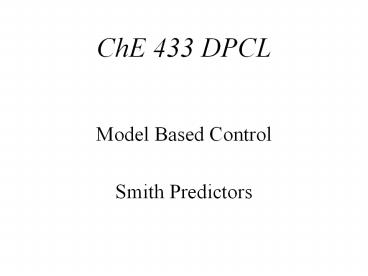ChE 433 DPCL - PowerPoint PPT Presentation
1 / 18
Title: ChE 433 DPCL
1
ChE 433 DPCL
- Model Based Control
- Smith Predictors
2
Model Based Control
- What can we do with a process model? Improve
performance. - 3 Methods
- Internal Model Control
- Model Free Adaptive Control
- Model based PID controllers
3
Internal Model Control
- Dynamic Matrix Control, DMC, forward projection
of a process change is placed in an array and
output changes are based on a least error squared
value of the projected process variable.
Multivariable handout - Minimal Prototype Controller, where the
controller output change is based on a projected
change in process variable. This algorithm does
not even use any elements from a conventional PID
algorithm.
4
Model Free Adaptive Control
- Uses neural network to control the process. The
output will move the process variable to the set
point based on an internal network, not
determined by the user. - Some reasonable understanding of the process
dynamics required. The process dynamics can
change and the algorithm will learn the new
conditions without being told to retrain itself.
5
MBC, Model Based Control
- Introduced to improve control response with
dominant dead time processes - Smith Predictor
- Concept If we know the process transfer
function, we can place the transfer function in
the feedback path and cancel the dead time effect.
6
Smith Predictor
- Smith Predictor describe how a model of the
process is placed in the feed back path. The user
believes that an exact calculation and
representation is required to implement the
technique. - Consider the elements in the feedback path as
compensation elements.
7
MBC Implementation
- The process model is divided into two sections,
one that models the process first order time
constants and a second that models the process
dead time. - The value of these terms are not precisely equal
to the process model.
8
MBC Implementation
- The controllers compensated dead time should be
smaller that the process dead time and the time
constants should be slightly longer than the
largest time constant. - The compensated dead time approx. 25 percent
shorter than the process dead time and the
compensated lag 25 percent longer than the
process time constants.
9
MBC Implementation
- It is not necessary for these compensating
elements be precisely defined. The estimated
values are usually sufficient. 85 - It is not necessary to know the exact process
gain - It is not necessary to have linear behavior the
algorithm is configured to compensate for the
model error.
10
MBC Implementation
- A standard PID algorithm with a remote set
point, CAS_IN, can be used if the model
compensating terms can be implemented in a
separating computing function block external to
the controller. - Without an offset between set point and the
algorithm output, and to correct for modeling
error, a model correction term, MC is the ratio
of the actual process variable to the output of
the total process model, W. - Model correction method should be implemented in
any advanced model based control system
11
(No Transcript)
12
(No Transcript)
13
(No Transcript)
14
Feed Forward to MBC
- The disturbance test was done without
implementing any feed forward. - Feed forward be implemented external to the
predicted algorithm. - Difficult to suppress the compensating action
based on the feed forward signal, move the valve
some amount and not allow the compensating
algorithm to adjust for the change. The algorithm
will correct for model errors as designed.
15
Potential Problems
- If dead time and time constants change
significantly, the control loop will operate with
choppy behaviour and not stabilize - Nonlinearity can be compensated
16
Integral Delay Dead Time Compensation
- Add a delay before the integral function. Change
in the error results in immediate change in the
proportional action, reset or integral behavior
will be delayed. - Integral delay time should be equal to the
process dead time. This prevents excessive
integral action.
17
(No Transcript)
18
Problems Implementing Integral Delay
- Most commercially available controllers don't
allow the user to configure the controllers
internal elements. DeltaV does not. LabView does. - Many do not offer delay or dead time function
blocks. A requires the controller manufacture to
use more dynamic memory, which increases the cost - Use multiple first orders to simulate a dead time































